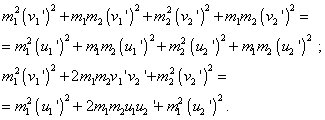V.5 No 1 |
61 |
| Three-body problem in collision theory | |
|
|
V.5 No 1 |
61 |
| Three-body problem in collision theory | |
|
|
Thus, we revealed from the analysis of bodies motion in frame Sm that the bodies' speeds and momenta are directed in a common line that goes through the interaction point, i.e. through the origin of this frame. And since Sm is an inertial frame, we may apply (8)- (9) to this interaction. In turn, it follows from this that, passing from the stationary frame S to the frame Sm, we reduce the 2 D problem of masses interaction to the 1 D problem whose solution we already know.
|
|
Fig. 4. Central interaction of bodies moving in one line
|
"In central collision, the vectors |
| (24) |
Solving (8) and (24) jointly, we yield |
 |
(25) |
[6, p. 61]. In this citation we dotted the bodies' speeds in order to refer them to our problem, to the mass centre frame. Analysing the presented solution, we have to mark, it is incomplete. To show it, let us follow this joint solving after the cited author. For it, let us square (24) and multiply each term of (8) by (m1 + m2). We will yield |
 |
(26) |
Subtracting now the second equality of (26) from that first, we yield |
| (27) |
This last equality will be satisfied in two cases: |
 |
(28) |
In the first case, substituting sequentially |
| (29) |
As we can see, this case relates to the statement of problem when the bodies did not interact. With it the bodies' momenta retained their initial values and we can record |
| (30) |
where Here we again encountered the duality of solution of which we said above. The solution for 1 D case actually premises the conservation of the system momentum as in case of non-interaction as in case of scattering. The first of these solutions is valid when the bodies come to the interaction point not simultaneously, as well as when the interaction of 'conventional' bodies has the wave nature, as for example in crossing trajectories of wave pulses propagating in continua. The second case is revealed in elastic collision. And we have to take these features into account in calculating the specific dynamic systems. Besides, "remember that in (25)
(as well as in (29) - Authors) the speeds v1 and v2 can have (in general case -
Authors) the same either opposite signs, dependently on directions
of vectors |
| (31) |
 |
(32) |